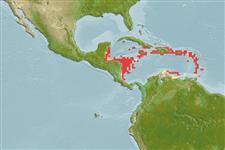Common names from other countries
>
Blenniiformes (Blennies) >
Chaenopsidae (Pike-, tube- and flagblennies)
Etymology: Acanthemblemaria: Greek, akantha = thorn + Greek, emblema, -atos, anything that is nailed, knocked in; also anything with bass or high relief (Ref. 45335).
Environment: milieu / climate zone / depth range / distribution range
Ecologia
marino associati a barriera corallina. Subtropical; 20°N - 10°N, 90°W - 58°W (Ref. 56264)
Western Atlantic: southeastern Florida (USA), Bahamas, and Yucatan, Mexico to the Greater Antilles and Panama. Antilles and western Caribbean (Ref. 26938).
Size / Peso / Age
Maturity: Lm ? range ? - ? cm
Max length : 4.0 cm TL maschio/sesso non determinato; (Ref. 7251)
Almost always found in holes of corals. Feed on amphipods and copepods (Ref. 5521). Main diet of benthic harpacticoid copepods (Ref. 94105). Oviparous (Ref. 56066). Eggs are attached to the walls of the parent's shelter and are brooded by the male parent (Ref. 56066).
Life cycle and mating behavior
Maturities | Riproduzione | Spawnings | Egg(s) | Fecundities | Larve
Oviparous (Ref. 56066). Males guard the eggs until they hatch (Ref. 56065).
Robins, C.R. and G.C. Ray, 1986. A field guide to Atlantic coast fishes of North America. Houghton Mifflin Company, Boston, U.S.A. 354 p. (Ref. 7251)
IUCN Red List Status (Ref. 130435)
CITES (Ref. 128078)
Not Evaluated
Threat to humans
Harmless
Human uses
Pesca: commerciale; Acquario: Commerciale
Strumenti
Special reports
Download XML
Fonti Internet
Estimates based on models
Preferred temperature (Ref.
115969): 27.3 - 28.2, mean 27.9 (based on 226 cells).
Phylogenetic diversity index (Ref.
82804): PD
50 = 0.5000 [Uniqueness, from 0.5 = low to 2.0 = high].
Bayesian length-weight: a=0.00457 (0.00183 - 0.01143), b=3.08 (2.86 - 3.30), in cm Total Length, based on LWR estimates for this (Sub)family-body shape (Ref.
93245).
Trophic level (Ref.
69278): 3.1 ±0.32 se; based on food items.
Resilienza (Ref.
120179): Medio, tempo minimo di raddoppiamento della popolazione 1.4 - 4.4 anni (tmax=4).
Fishing Vulnerability (Ref.
59153): Low vulnerability (10 of 100).
